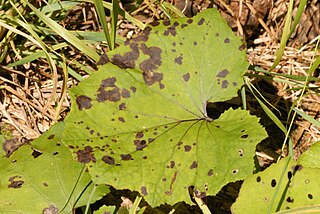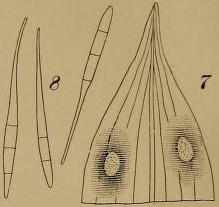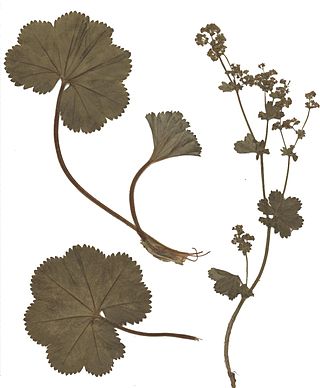
Viola canina, commonly known as heath dog-violet and heath violet, is a species of the flowering plant in the violet family Violaceae. It is native to Europe, where it is found in heaths, fens, and moist woodlands, especially on acidic soils.

Alchemilla alpina, commonly known as alpine lady's-mantle, is an arctic-montane herbaceous perennial plant native to Europe and Southern Greenland.
Ramularia beticola is a fungal plant pathogen infecting beets.

Ramularia brunnea is a fungal plant pathogen infecting strawberries. It was first described scientifically by American mycologist Charles Horton Peck.
Ramularia coryli is a fungal plant pathogen infecting hazelnuts.
Ramularia cyclaminicola is a fungal plant pathogen infecting cyclamens.
Ramularia macrospora is a fungal plant pathogen infecting bellflowers.
Ramularia menthicola is a fungal plant pathogen infecting mint.

Ramularia primulae is a fungal plant pathogen infecting Primula.
Ramularia spinaciae is a fungal plant pathogen infecting spinach.

Mycosphaerella is a genus of ascomycota. With more than 10,000 species, it is the largest genus of plant pathogen fungi.

Lysimachia vulgaris, the yellow loosestrife or garden loosestrife, is a species of herbaceous perennial flowering plant in the family Primulaceae. It was transferred to Myrsinoideae based on results of molecular phylogenetic research before being merged into the Primulaceae.

Ramularia is a genus of ascomycete fungi. Its species, which are anamorphs of the genus Mycosphaerella, are plant pathogens. Hosts include Narcissus and barley.
The Quambalariaceae are a family of fungi in the class Exobasidiomycetes. The family contains the single genus Quambalaria, which in turn contains five species. Quambalaria was circumscribed in 2000 to accommodate plant pathogenic species—previously classified in Ramularia and Sporothrix—that were known to infect Corymbia trees in Australia, causing a leaf spot and shoot blight and canker disease.

Cercosporella is a fungus genus in the family Mycosphaerellaceae.
Ramularia vallisumbrosae is a fungal plant pathogen infecting daffodils (Narcissus), causing narcissus white mould disease.

Ramularia rubella is a plant pathogen in Ascomycota that infects Rumex species. Infection produces reddish spots on leaves. The red color is caused by the production of rubellin, a photodynamic anthraquinone-derived phytotoxin. R. rubella was originally described from Rumex aquaticus in Germany; it has a wide geographic range on Rumex species. It is being investigated as a biological control agent of Rumex obtusifolius.

Ramularia ulmariae is a fungal species described by Cooke in 1876. Ramularia ulmariae belongs to the genus Ramularia and the family Mycosphaerellaceae. No subspecies are listed in the Catalog of Life.

Alchemilla filicaulis is a species of plants belonging to the family Rosaceae.










